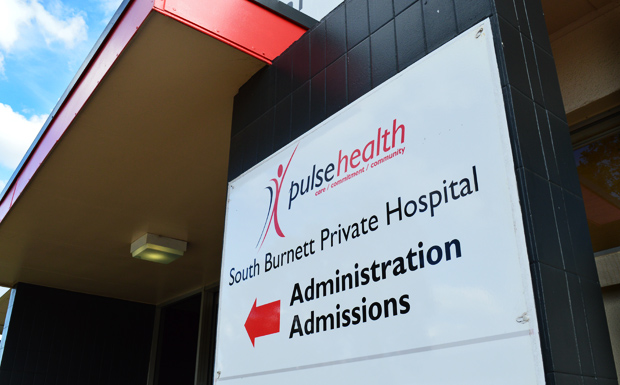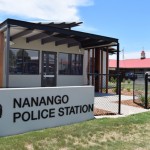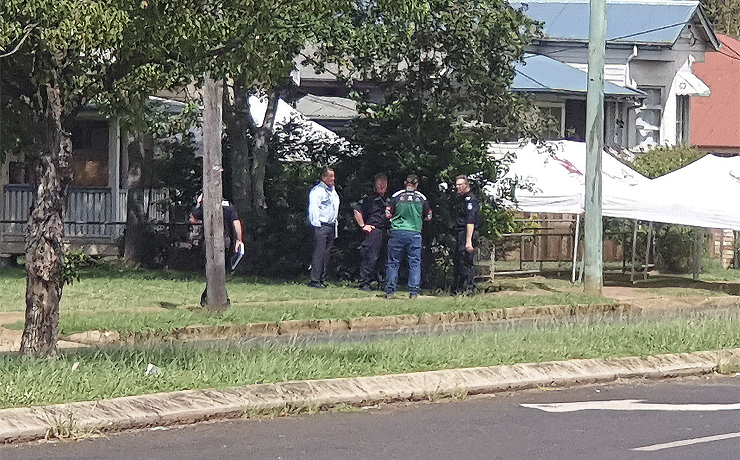
January 21, 2016
The South Burnett Regional Council voted 5 to 2 on Wednesday to take over the licence of the South Burnett Private Hospital.
The licence is currently held by Pulse Health, who ceased to operate the facility on June 30 last year.
Pulse Health agreed to keep the licence open until March 31 to allow the Council time to find another operator and effect a licence transfer but a six-month search by Mayor Wayne Kratzmann has so far proved fruitless.
At Wednesday’s meeting, Councillors voted to allocate $150,000 to transfer the hospital’s licence from Pulse Health to Council, and engage a health specialist to negotiate health fund rebate contracts and prepare a business plan for the facility.
Councillors also voted to rename the hospital the “Lady Florence Bjelke-Petersen Community Hospital” in recognition of Lady Flo’s contribution to the South Burnett community.
Council will also continue to provide administrative support for visiting specialists operating from the hospital.
The motion also resolved to reopen the hospital with a proposed commencement date of September 1, however this was subject to provisos:
- That a revised business model addressing existing gaps in hospital and medical services can be developed;
- That the revised model can be run on a cost-neutral basis for ratepayers;
- That national accreditation can be obtained; and
- That the financial impacts of the revised model be considered as part of Council’s 2016-17 Budget deliberations.
The motion will make the South Burnett Regional Council the hospital’s operator as well as the building’s owner.
The decision to engage a health specialist and prepare a business plan for the facility means Councillors have effectively shifted the burden of a final decision about the hospital’s future to the incoming 2016-2020 Council.
* * *
Mayor Wayne Kratzmann opened the meeting by discussing the activities he had undertaken over the previous six months to find a new operator, and the modelling undertaken by consultants Ernst & Young.
He said Ernst and Young had modelled three scenarios:
- Council operating a full private hospital under licence to Queensland Health
- Council operating a hospital day surgery under licence to Queensland Health, together with leased auxiliary services such as rehabilitation, specialist consulting rooms, mental health services or other services that filled gaps in existing medical services
- Council leasing the building to medical practices without a Queensland Health licence
The modelling indicated that if the hospital achieved a 40 per cent bed occupancy rate – the lowest level it had achieved in the last two years – it would lose $500,000 a year.
However, if the bed occupancy rate could be lifted to 52 per cent – which was its normal occupancy rate – it could be run at a slight profit.
The Mayor added that during discussions with Queensland Health last week, new information had come to light on a possible structure for the hospital which could maximise its bed occupancy rates and potentially reduce its operating expenditure.
He said the new model needed to be further explored, and that was why the motion proposed engaging a health specialist to draw up a business plan.
The Mayor said the $150,000 which would be allocated for this would come from a recent Budget windfall Council had received so there would be no effect on the current capital works program.
While acknowledging the financial implications of Council running a hospital were an important part of the day’s deliberations, Mayor Kratzmann said Councillors also needed to consider the long-term benefits for the region:
- The hospital generated approximately 15 full-time equivalent jobs and contributed an estimated $2.6 million per annum into the local economy, directly and indirectly
- It provided opportunities for local residents to be treated locally by visiting surgical and medical specialists
- The provision of high quality health services had been identified as a critical factor in attracting new businesses to the region
* * *
Deputy Mayor Cr Keith Campbell said he would not support retaining the hospital if it could not be run at a profit or, in a worst case, at zero cost to ratepayers.
In that scenario, Council should call for expressions of interest to run a business in the building, medical or otherwise. And if that failed, then the property should be put on the market.
But he would be supporting the resolution because he believed the hospital could be run at a profit, and spending $150,000 to develop a business plan was a one-time investment in finding the right way to do it.
“For those who say this is wasting ratepayers’ money, I’d like to compare this to the cost of running a number of other Council facilities that are only used by a small percentage of ratepayers, such as swimming pools,” he said.
“It costs the Council $800,000 a year – each and every year – to keep our pools’ doors open. But start talking about closing a swimming pool and see what type of public reaction you get.”
* * *
Cr Deb Palmer said she would be supporting the resolution.
Cr Palmer said she thought the hospital was an essential component of the region’s health system.
She wanted to give it every possible chance to be reopened, providing it could be done in a way that was cost-neutral to ratepayers.
* * *
Cr Ros Heit said she had spent many sleepless nights agonising over the decision but would be voting against the resolution because there was a very real risk the hospital would run at a significant loss.
She said while she commended the effort the Mayor and staff had put into trying to find a new hospital operator, the fact that they couldn’t raised question marks about why Council felt it could run it any better.
“I feel agreeing to this proposal is just spending $150,000 to delay by a few months the inevitable decision to not operate the hospital. That doesn’t seem to be good decision-making by this Council, so I am not in favour of this proposal,” she said.
* * *
Cr Barry Green said he was in favour of keeping the hospital open, reminding Councillors that 20 years ago Nanango Hospital was on the brink of closure and had been saved by the former Nanango Shire Council and community action.
“Today that hospital is running 24/7 and is an indispensable part of our health care system,” Cr Green said.
“I’d also remind Councillors that the South Burnett sits in the top 20 per cent of population growth areas in Australia, and we will need this hospital in the future.”
* * *
Cr Damien Tessmann said he had been born at the private hospital; had been a patient there when he broke his arm in Grade 6; and in 2011 his father had been hospitalised there for several days when he was injured.
Both his paternal grandparents had passed away in the hospital as well as a very close relative, and they had all spent their last moments in peace and comfort there in the town where they all felt the most comfortable.
He said his cousin had worked as an Enrolled Nurse there, and his sister works for QML now while she studies to become a nurse. And he believed the hospital had become almost as recognisable as the peanut silos for generations of South Burnett residents.
However, after a lot of deliberation, he had decided to vote against the resolution.
“I cannot turn my mind from the fact that not-for-profit companies along with for-profit companies have turned this hospital down, particularly the not-for-profit sector,” Cr Tessmann said.
* * *
Cr Kathy Duff said she would support the resolution.
“Visiting specialists are a major attraction for rural residents, and many patients come from smaller towns,” she said.
“Keeping this facility operating is a no-brainer for our region.”
* * *
Mayor Wayne Kratzmann said that in the end, the decision was “all about people” – and particularly the 27 per cent of the region’s population that were elderly.
“We have an ageing population, and we owe it to our residents to do whatever we can,” he said.
“Terry Fleischfresser’s recent article in southburnett.com.au got it right, and if we save even one life with this then I’m very happy.”
The motion was put and carried 5 to 2, with Crs Tessmann and Heit opposed.
Related articles:
- Candidate’s Solution ‘Laughable’: Tessmann
- What You Voted For
- Views From Two Candidates
- More Delays Likely Over Hospital
- Hospital Meeting Now On Thursday
- Brown Blasts Council Over Hospital
- Hospital’s Fate Decided Next Week
- South Burnett Private Hospital Decision Delayed
- Hospital Decision Soon
- Council To Vote On Running Hospital
- Council Candidate Claims ‘Ego, Emotion’ For Hospital Decision
- Talk Of ‘Plan B’ Angers Mayor
- Doors Still Open At Private Hospital
- Mayor Hits The Road
- What More Can We Do?
- Huge Response To Hospital Campaign
- Why I Want To Be Mayor
- Mayor Appeals For Public Support
- Council Still Looking For Hospital Operator
- Still A Glimmer Of Hope For Hospital
- Hospital Deadline Looming
- Council In Talks With Qld Health
- Why We Need Our Private Hospital
- Closure Would Be ‘Absolute Disaster’
- Fingers Crossed For Private Hospital
- Mayor Off To Brisbane For Hospital Talks
- Mayor Gutted Over Hospital Closure
























Today’s decision is not that of a majority but of weighted voices that hold sway over democracy.
This principle of leadership is based on the concept of human inequality. It is not true that all men are equal – that there are the intelligent and the stupid, the industrious and the lazy, the good and the bad, that particular peoples are different, and so within a people their voices shall have no weight.
That it is a mistake to believe that under a “people’s government” it goes well for the people. That experience has shown that parliamentary democracy leads to the ruin of it’s people and a people can only experience progress when a leader stands at its head and commands the masses to his will.
Arguing for dictatorship?
A dictatorship comes in many forms Rod. A system of government that controls and limits public choice that predetermines the outcome of a issue or by a controlled system of “choices” that all invariably lead to the same end.
How fortunate for governments that the people they administer don’t think.